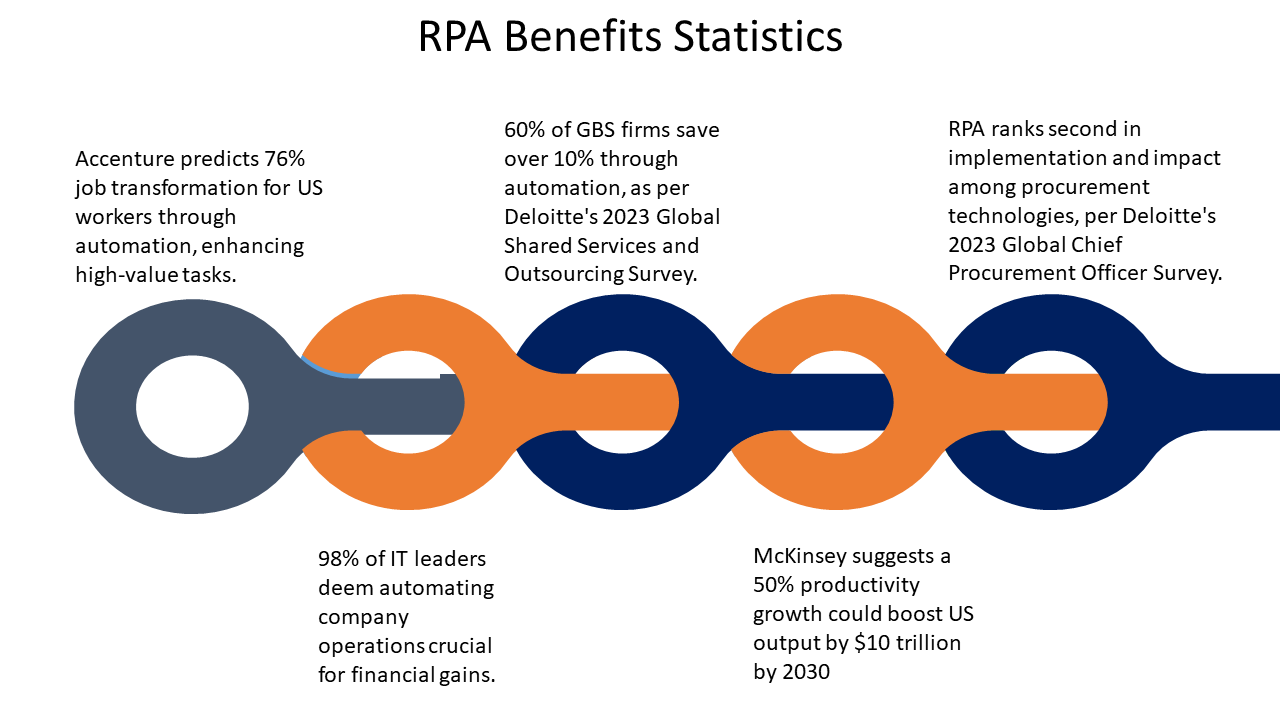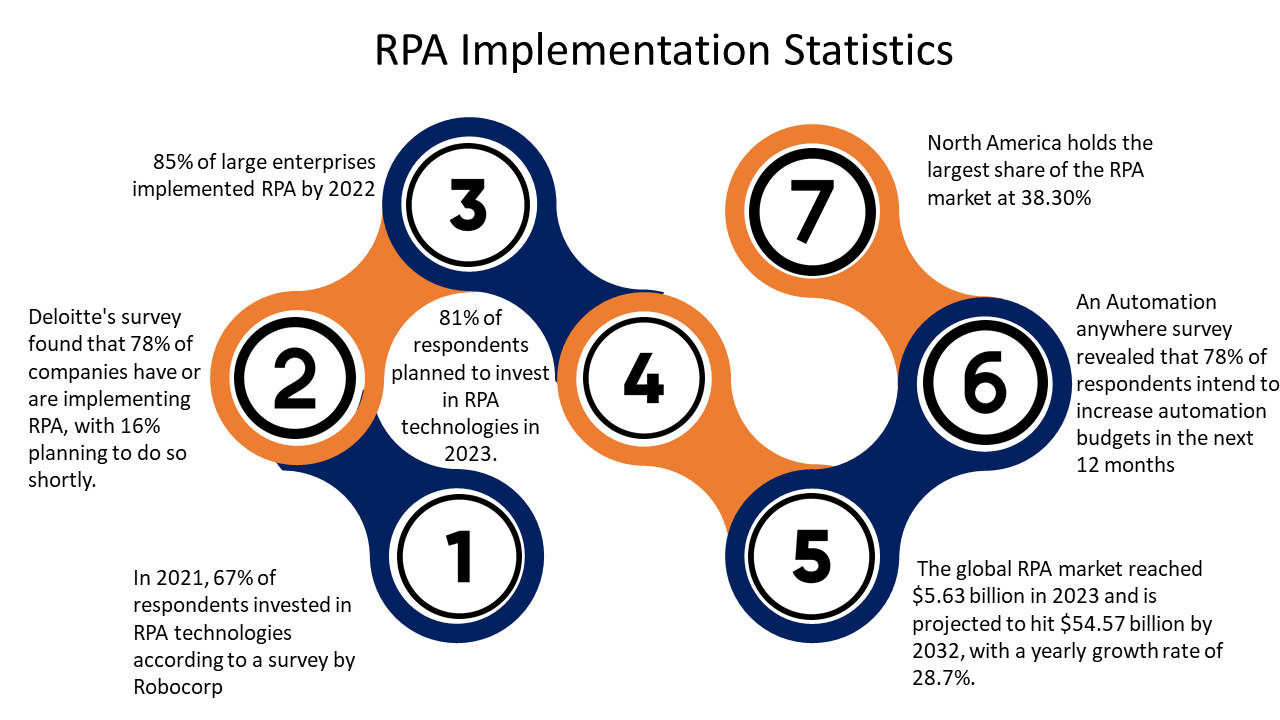Table of Contents
Are repetitive HR responsibilities giving you a headache? Are you fed up with manual, labor-intensive procedures holding down your HR team? Furthermore, do you imagine a world in which payroll, onboarding, and data entry are all completed quickly and effectively, freeing up your precious HR staff members to work on more important projects? That’s where RPA solutions comes in.
The market for Robotic Process Automation (RPA) is predicted to increase at a rate of 28.7% annually, from its estimated $5.63 billion in 2023 to $54.57 billion in 2032. According to the Robotic Process Automation Market Size Report 2023-2032. Automation of Processes (RPA) may hold the key to the solution. HR is one of the many industries where this cutting-edge technology is revolutionizing companies. Overall, this comprehensive handbook provides all the information you require to integrate RPA solutions into your HRMS software. Together, let’s design a future where robots take care of repetitive tasks, freeing up your HR staff to concentrate on cultivating a strong workplace culture and luring top talent.
Introduction
The modern business has changed due to automation. Furthermore, as businesses face the difficulty of operating flawlessly in a digital environment, the potential to implement robotic automation in business processes has gained increasing attention.
According to Accenture, “automating monotonous operations and enhancing high-value ones may reimagine 76% of the jobs performed by US workers.”
Using RPA solutions, businesses actively automate knowledge-based professional service activities that do not require human interaction. Simultaneously, it is functioning as a fundamental activist against the mainstream understanding of labor arbitrage. Although it is a relatively new technology, RPA has strong business process management roots. This blog will examine RPA services and their development in business processes.
Remove Errors and Boost Accuracy Upto 100% By RPA Solutions
An Overview of Robotic Process Automation and Its Solutions
The art of RPA is the use of software robots to communicate with IT systems and Software-as-a-Service applications to automate rule-based manual tasks related to transactional and repetitive processes. Furthermore, the robot simulates how an employee benefit software solution might use the user interface of a system.
Without changing the current infrastructure or systems, robotic process automation companies offer improved efficacy and efficiency across a range of business applications, as well as data security. One way to describe the technology used in fields like artificial intelligence, automation engineering, and machine learning solutions is robotic process automation.
When considering repetitive commercial operations, one could argue that adopting automated processes poses a lower risk compared to utilizing highly skilled human personnel.
Moreover, RPA caters to non-technical business professionals who seek technology that automates tasks instead of requiring them to perform independently.
What are RPA solutions for Businesses?
The modern business has changed due to automation. Furthermore, as companies face the difficulty of operating flawlessly in a digital environment, the potential to implement robotic automation in business processes has gained increasing attention. Using RPA solutions, businesses automate knowledge-based professional service activities that do not require human interaction. Simultaneously, it functions as a fundamental activist against the mainstream understanding of labor arbitrage.
Automation technologies are revolutionizing the way businesses function. RPA utilizes a scalable, digital workforce to streamline manual operations and lighten the workload on people by using human resource management software solutions and bots to handle repetitive tasks that can be completed more quickly and precisely.
When robotic process automation (RPA) emerged, people nearly only utilized the phrase to describe user interface-level systems and application manipulation. The “robotic” aspect of the term arises from the fact that the robot uses systems like those of a human user, including pressing buttons, entering login information into websites, reading text from PDFs, and so on.
The foundation of robotic process automation remains this definition. On the other hand, companies are marketing the technology as an increasingly comprehensive enterprise automation solution as it advances. In addition to having advanced enterprise-class functionality and extensive integrations, it should be able to communicate with a graphical user interface.
This change in emphasis also broadens the advantages of robotic process automation companies, which can now fuel an enterprise-wide digital transformation and save users several hours on desktop duties. Because RPA consultants are versatile, scalable, and effectively connect operations across the whole enterprise, opportunities for automation exist almost everywhere inside the business.
How RPA is Beneficial in Business

1. Cost-effective
Using robotics can reduce operational costs by up to 25–50%. Comparatively speaking, people work 8/5 and have a set number of annual leaves, whereas robots can work around the clock and never take a holiday.
If robots replace some of the labor-intensive tasks that humans perform by hand, the company may see obvious benefits. Furthermore, automation can assist you in quickly recouping your investment, after which it will only be about making money!
2. Quality & Accuracy
RPA increases accuracy by providing better services to processes with a high likelihood of human error. Robots are dependable, consistent, and do not complain when required to labor nonstop. Additionally, they dramatically raise the output quality and decrease the number of reworks.
The best thing about this situation is that robots adhere to all guidelines precisely, producing 100% accuracy in the process results. Let’s also not forget that the technology is implemented quickly, which makes this bargain even sweeter. RPA maximizes an organization’s potential to expand its capacity.
3. Uniformity
As a safe, nonintrusive technology, robotics offers flawless uniformity in task execution across the board, every single time, without interfering with natural processes.
4. Better Analysis
Having access to correct, error-free data from multiple sources enhances the procedure, improving decision-making and the overall execution of the process.
5. A rise in worker productivity
In the end, RPA lets people and machines do what they do best. RPA frees up employees’ time from repetitive duties so they may concentrate more on client and customer engagement, relationship management, and other tasks that human beings are naturally good at. Moreover, a better business can only result from happy clients and customers.
6. A Higher Level of Customer Contentment
Increased customer and client satisfaction results from producing work of higher quality with greater accuracy and better customer/client engagement, which in turn increases the company’s goodwill.
7. Faster
In this case, bots execute tasks, enabling the completion of more work in a comparatively shorter length of time. Automation makes accurate and speedier delivery the standard.
8. Integration Across Various Systems
Robotic process automation in HR makes counting data and information from several systems feasible, producing data that aids in process integration.
9. Flexibility
RPA in human resources can handle various jobs and is useful in many industries. Furthermore, any procedure that follows the rules repeats and can be defined as repeatable constitutes an ideal automation candidate.
10. Improved IT Administration and Support
RPA monitors the network and raises the service desk’s operational standard. Moreover, this allows businesses to manage transient increases in demand without hiring or educating more employees on employee benefits platforms.
Role of Robotics Process Automation Solutions in HR Processes
The HR division is the center for various activities, including hiring and onboarding, payroll processing, managing employee performance, compliance reporting, and more. Furthermore, RPA has become ingrained in many areas of HR operations, offering unmatched advantages that transform the way HR professionals work.
.
1. Employee Onboarding and Offboarding Processes Made Simple
An employee’s journey with the company begins with onboarding and ends with offboarding procedures. Furthermore, RPA streamlines and expedites these procedures by producing offer letters, employment contracts, and other paperwork.
It ensures that we provide new hires with the necessary resources and swiftly remove access permissions for departing employees. It does this by automating access provisioning and de-provisioning to multiple systems.
2. Effective Processing of Payroll
One of the trickiest and longest-taking jobs in HR is processing payroll. RPA provides paystubs quickly and accurately while managing data entry and calculating salaries, deductions, and tax withholdings. Ensuring prompt and correct employee payments eliminates payroll errors and increases employee satisfaction overall.
3. Simplifying Attendance and Leave Administration
HR departments may find it challenging to keep track of employee leave requests and attendance records. Furthermore, real-time attendance data updates, leave balance calculations, and leave application processing are all handled by Robotic process automation. This enables HR managers to handle leaves of absence properly and guarantee precise payroll deductions.
4. Speeding up the Hiring Process and Screening
The hiring process includes sorting through many resumes, assessing candidates, and conducting initial evaluations. Furthermore, RPA in business automates and improves these procedures by collecting relevant information from resumes, matching it to job criteria, and shortlisting applicants based on predetermined standards. Overall, this expedites the hiring process and allows for quicker recruiting decisions.
5. Improving Documentation and Compliance
HR procedures are guaranteed to follow internal and regulatory guidelines via RPA. It can produce compliance reports, track license and certification expiration dates, and guarantee regular compliance with regulations. Furthermore, doing this document management reduces the possibility of encountering compliance problems and potential fines.
6. Improving Workplace Performance Evaluation
Robotic process automation automates processes for evaluating employees, guaranteeing data consolidation, timely reminders, and gathering feedback. Furthermore, this enhances transparency, streamlines the performance management cycle, and makes data-driven choices for succession planning and talent development possible.
7. Enhanced Workplace Environment
HR departments may enhance employee experience, rapidly address inquiries, and resolve problems by automating repetitive operations. We bolster employee involvement and foster a positive work atmosphere.

How to Get Started with Automation In HR?
There are numerous advantages that RPA brings to HR processes, such as increased productivity, cost savings, and improved employee satisfaction. These incorporate automation technology into numerous HR functions by automating repetitive operations like data entry, hiring, and integration. As a result, your HR staff will have more time to concentrate on strategic duties that call for human intelligence, including talent development and employee engagement.
Proper planning and execution are necessary to ensure the success of HR automation. Below is a seven-step approach to implementing HR automation tools. By adhering to this method, you may enhance management overall and optimize the advantages of HR automation.
1. Identify your human resources procedures
Effective HR automation requires a detailed comprehension of your current HR procedures. Thus, evaluate your current workflow before choosing which operations to automate.
Identify the current procedures in place, assess the time and money invested in them, and identify the tasks that can be automated. Furthermore, you can find process bottlenecks, inefficient sections, and redundancies by mapping out your current HR procedures.
2. Locate the possibility of automation
The next stage is to find opportunities for HR automation. Examine the duties you can automate after you’ve mapped out your HR procedures. Moreover, seek laborious, repetitive jobs that involve a lot of manual data input, scheduling, or maintaining staff records.
Maximizing productivity with HR automation solutions requires identifying areas where automation can minimize errors and enhance accuracy. Furthermore, give your HR procedures a thorough evaluation, noting the places where automation will have the most effects.
By automating these chores, HR staff may work more productively, make fewer mistakes, and concentrate on other important duties. Additionally, automation can aid in process standardization throughout the company, guaranteeing uniformity in HR activities.
3. Select appropriate HR automation resources
During the deployment process, choosing the appropriate HR management software is essential. Choosing the best platform for your business might not be very clear when there are so many possibilities available. However, if you carefully evaluate a few important elements, you can choose the platform that best suits your demands.
Cost must be taken into account when choosing employee benefit administration software. After deciding on your spending limit, assess the platforms that you can afford. Furthermore, investing in the appropriate platform can achieve long-term cost savings.
Scalability is still another critical factor. Select a platform that can expand with your company and change to meet evolving requirements. Furthermore, the platform must adapt to new features and allow for integrations with other HR tools.
4. Configure and set up the system
The next step is to set up and configure the HR automation platform to work with your HR procedures after choosing the best one. It’s critical to allot adequate time and resources to ensure that you set up platform configuration and setup correctly, as it might be complicated. This could include defining permissions for various user roles, setting up procedures, and creating user accounts, depending on the platform.
Close collaboration with your vendor or IT team is imperative to ensure that the platform is appropriately set up and matches your company goals. Moreover, you must test the platform to ensure that data moves between HR systems smoothly and that all integrations function as intended.
5. Run a system test
You must properly test the HR automation system to find and fix any potential problems before implementing it for your staff. By conducting a test run, you can ensure that all integrations operate as intended and that the system operates as expected.
Testing entails simulating numerous scenarios to verify that the system is capable of handling diverse use cases. To check the system’s functionality, you may, for instance, mimic the hiring process or the leave request procedure. It’s crucial to test the system’s scalability to make sure it can manage a growing burden as your company expands.
It is essential to include a wide range of stakeholders in the testing phase to get input and find any problems that might have been missed during implementation. It’s also essential to document any problems that arise during testing and work with the vendor or IT team to address them promptly.
6. Train workers
Give every employee utilizing the new platform thorough training and assistance. Provide access to a help desk or support staff, conduct training sessions, and write user manuals or tutorials. Furthermore, providing staff with continuous guidance and resources is imperative to help them acquaint themselves with the new system.
Throughout the training session, encourage your staff to offer feedback and pose questions. This input can help you find areas where the system needs improvement and clarify unclear or confusing elements. It can also improve team engagement and buy-in to the new system.
Employee education is essential, but so is informing them of the advantages of the new HR automation platform. Stress how the system will facilitate their work, boost efficiency, and enhance HR procedures. This has the potential to boost adoption rates by igniting interest in the new platform.
7. Continue to improve the platform
Review the system frequently to find any areas that might need an audit. Conduct regular audits to ensure the system operates appropriately and complies with all applicable laws. Routine audits and evaluations will maintain system efficiency and find possible problems.
This means that the HR automation platform needs to be improved going forward. The platform may be modified, and the tasks and procedures may be updated.
To fully reap the rewards of RPA in HR processes, constant development is essential. So that you may increase general efficiency and the operation of the platform, and solicit input from stakeholders and employees.
Stop Spending Time On Long Manual Tasks. Start Automating by Implementing RPA in Business
Specific Use Cases of RPA in HR
Here are some case studies and instances of HR automation used by businesses, along with the advantages it offers to both the companies and the personnel.
Among the hiring procedures are:
- publishing job postings,
- monitoring replies, reviewing CVs,
- pre-employment evaluations,
- arranging applicants according to predetermined standards,
- email chains that are automated.
Your HR team will waste time on ineffective administrative chores if you don’t automate them from these operations.
CASE STUDY: Florida’s Osceola County Sheriff’s Office
The Osceola County Sheriff’s Office utilized a paper-based hiring procedure. This procedure entailed a massive backlog of paperwork, misplaced forms, and a breakdown in communication between the departments and the applicants.
In response to the national police officer shortfall, they automated the pre-employment online evaluation process through HR.
This led to a rise in applications the following year, in 2012, from 446 to 1,305 in the first year. Photos could be uploaded, and forms were accurately filled out—no fields could be left empty, unlike paper versions. The increasing number of applications ultimately led to the Sheriff’s Office finding better quality individuals.
Thanks to the HR automation process, they were also able to send candidates automatic emails informing them of the status of their applications and conduct paperless background checks. They also saved the first $2,000 on office supplies for files related to new hires.
2. Onboarding of Employees
The many tasks involved in employee onboarding include gathering verification documents, completing paperwork, granting recruits tool access, submitting device requests, and much more.
During the onboarding process, HR automation might offer a simple checklist. This includes the capacity to establish automated workflows for approval and notification, gather e-signed forms and produce official PDF documents instantly, rapidly distribute devices to staff members without having to wait for IT support, and much more.
CASE STUDY: Belgium’s KPMG
For new personnel at KPMG, there was a lengthy waiting period between signing a contract and the first day of work because the company lacked a pre-boarding procedure.
To address this problem, the business employed an integrated and secure onboarding HR management software solution. The onboarding process begins as soon as the new hire signs the employment contract. Before their first day on the job, new hires receive all the necessary and useful information instantly from the app.
After utilizing the HR automation tool for two years, KPMG staff members gave their hiring process a 4.45 out of 5 rating and their first week a 4.12.
3. Expense reports
38% of workers said that managing and filing costs is tedious, and over 60% said they hated doing it.
Needless manual duties like filing expenses negatively impact employees’ satisfaction at work. As a result, their performance and productivity have been shown to suffer. Smooth workforce management software translates into increased productivity, which improves business performance.
Employees are usually required to turn in the receipt, complete a form with all the information, and have it authorized by management. Forms accumulate and wait on people’s desks. These may be filled out incorrectly and lost. Roughly one out of every five manual expense reports is submitted in error.
The expenditure process can be digitalized with HR automation. Workers can use their phones to upload a snapshot of their receipts, and expense management software will automatically extract the necessary information (amount, merchant, VAT, etc.).
When an employee submits something, the appropriate management is notified immediately and has the option to accept or reject it. Then, a controller verifies that the information is accurate and clicks through to process it.
This eliminates human mistakes, saves workers up to 70% of processing time on average, and provides businesses with a real-time expenditure perspective.
4. Payroll Management
Computing the number of hours or days worked by hand, in addition to sick or vacation days, presents many opportunities for error. As a result, employees are either overpaid or underpaid.
HR automation may streamline the process by tracking and calculating everything automatically, streamlining payments, and making data much easier to locate in case it’s needed for a compliance audit or other purpose.
CASE STUDY: FuelCell Energy in Connecticut
With her small crew, HR director Sandi Mauro carried out her routine. She obtained workers’ compensation figures from management and created a series of Excel spreadsheets, which she then forwarded to payroll for processing.
However, the payroll manager noticed a problem after the payroll was finished. Mauro looked into it and found that one of the files had been organized wrong, meaning all 600 employees were scheduled to get someone else’s salary.
FuelCell Energy quickly decided to invest in HR automation software to reduce human error, save time, and provide employees with greater transparency into their pay calculations.
Planning compensation used to take an entire month. In contrast, using the new system takes a week and is error-free.
5. Benefits for employees
Benefits management services, sometimes known as professional employer organizations (PEOs), frequently handle health care, retirement pensions, workers’ compensation, and other benefits for several firms.
This is problematic since workers typically know little to nothing about the kinds of benefits that are available to them while they are employed.
Automation software can monitor every employee’s condition and inform them of their benefits, even if their circumstances alter. Here’s an illustration of employee self-service.
CASE STUDY: Grolsch
As a business grows, keeping track of every employee’s preferences and changes becomes increasingly difficult.
As a result, the automated HR system “My Benefits” was purchased by the brewing business Grolsch.
When an employee records a change, the system shows their current status and benefits. As a result, every single employee has a far greater understanding of the benefits that are accessible to them.
A satisfaction study revealed that using My Benefits resulted in higher satisfaction—a score of 8.2 out of 10 compared to the previous paper-based system’s 6.8.
Leverage the Power of RPA for Transforming HR Processes by Partnering With A3Logics
A3Logics unlocks RPA’s potential to revolutionize your HR through:
1. Identifying bottlenecks:
They examine your HR procedures to identify where robotic process automation in human resources automation is most appropriate.
2. Customized Solutions:
They develop unique RPA solutions that align with your current HR system.
3. Effective Implementation:
A3Logics guarantees a seamless shift to RPA, reducing interference.
4. Ongoing assistance:
To enable your HR staff to maximize the benefits of RPA, they offer ongoing assistance and training. You get more than simply an RPA supplier when you work with A3Logics—you get a reliable advisor. Your HR team will be able to concentrate on what matters—your employees—by using RPA to expedite HR activities, increase accuracy, and free up time.
Key Takeaway
Hopefully, you now understand how RPA can completely change HR procedures. RPA solutions can help your department run more smoothly, increase accuracy, and free up your HR staff to work on key projects. Recall that thorough planning and solid collaboration are necessary for an effective RPA deployment.
Assess your demands and select a trustworthy RPA vendor to bring efficiency and efficacy in your processes
FAQ
1. What areas are covered under automation of HR processes?
RPA automation is great for repetitive, rule-based functions like payroll, onboarding, and data input.
2. Can HR positions be replaced by RPA?
No. RPA would automate tasks, not jobs. This allows human resources specialists to concentrate on more advanced tasks such as talent management and employee relations.
3. Is implementing RPA difficult?
Implementing RPA may be easy and productive if it is planned well and has a knowledgeable partner. Select a supplier who provides thorough training and assistance.
4. What security issues are associated with RPA?
The most important thing is security. Ensure access controls are clearly defined and your chosen RPA solution has strong security features.
5. How can I measure the success of robotic process automation in HR?
Track key metrics like processing times, error rates, and employee satisfaction to gauge RPA’s impact on your HR department.
6. How much is the cost of implementing robotic process automation in HR?
Costs vary depending on the complexity of your needs. However, the long-term benefits by automation such as increased efficiency and productivity outweighs the initial investment.
5. How can we assess the effectiveness of robotic process automation in HR?
Businesses must monitor important metrics, including processing times, error rates, and employee satisfaction, to determine how RPA is affecting their HR departments.






